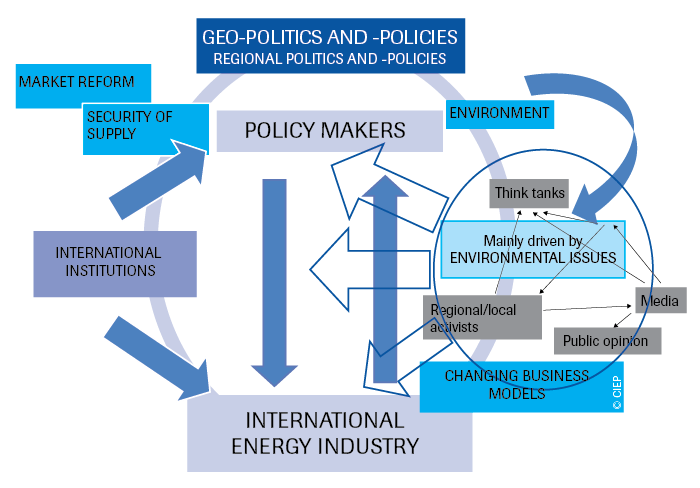Threat assessment
Introduction
The security of energy supplies is important for the general security of the European Union (EU). The definition of security of energy supply adopted in this contribution corresponds to the one used by the International Energy Agency (IEA), namely “the uninterrupted availability of energy sources at an affordable price”, and is sometimes also referred to as energy security (see Figure 1).[2]
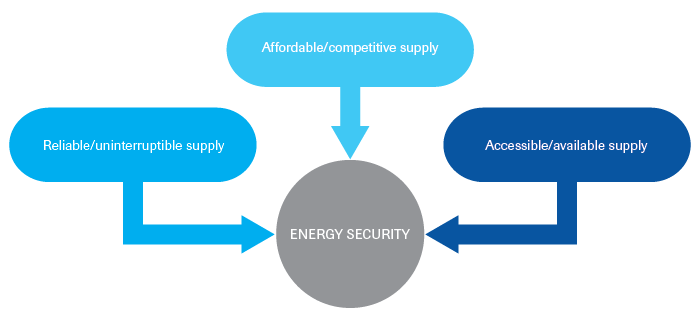
The IEA makes a distinction between short- and long-term dimensions of security of energy supply. On the one hand, long term concerns are mainly about ensuring that investments are timely and in line with overall economic development and sustainability goals. On the other hand, short-term security of supply focuses on the ability of the energy system to react promptly to sudden changes within the supply-demand balance.
Note that a 2010 EU regulation adds that security of supply policy measures relating to natural gas must be cost-efficient, ‘in order not to affect the relative competitiveness of this fuel compared to other fuels’.[4] Hence, the EU has added an extra consideration to the implementation of this part of the EU member states’ security of supply policy, in an attempt to take account of the considerable differences in the member states’ energy economies and the possibilities for mitigating any disruption of supply. To be sure, possible mitigating measures might include a temporary reduction in the supply of oil, gas or coal (to certain consumers), the holding of strategic and commercial stocks (in the case of oil, a requirement under IEA and EU policy; in the case of gas, under EU agreements only), domestic production, temporary demand restriction and diversification with regard to (energy) source and (geographical) origin.
The definitions of security of energy supply include its operational, strategic and long-term aspects, but do not mention its geopolitical aspects, despite the fact that the latter are often (rightly or wrongly) the reason for adopting (more) policy measures.[5]
Diversification of (energy) source and diversification of origin (of imports) are often the most important measures and are central to security of energy supply policy; however, it is by no means always possible (or desirable) to achieve them. Importing countries will generally need to strike a balance between the use of a cheap import option and more costly (domestic) diversification options. It will be far cheaper (more affordable) for a country that has no access to the sea and/or lies on a major pipeline route to buy energy from this one supply line (which is not, however, diverse in origin), than to diversify its energy supply with respect to (geographical) origin. If it attempts the latter course, energy will, for example, have further to travel from the energy source to the market. In some cases, the infrastructure may be lacking (or the flow may be in one direction only, as with natural gas and oil) to attract alternative forms of supply. Good connections in the EU internal market make a significant contribution to the security of energy supply the member states. The diversification of energy sources can also clash with other policy objectives such as climate policy (if coal is used instead of gas, oil or renewables for electricity generation), the balance of payments (due to foreign currency payments), the state budget and/or foreign policy.
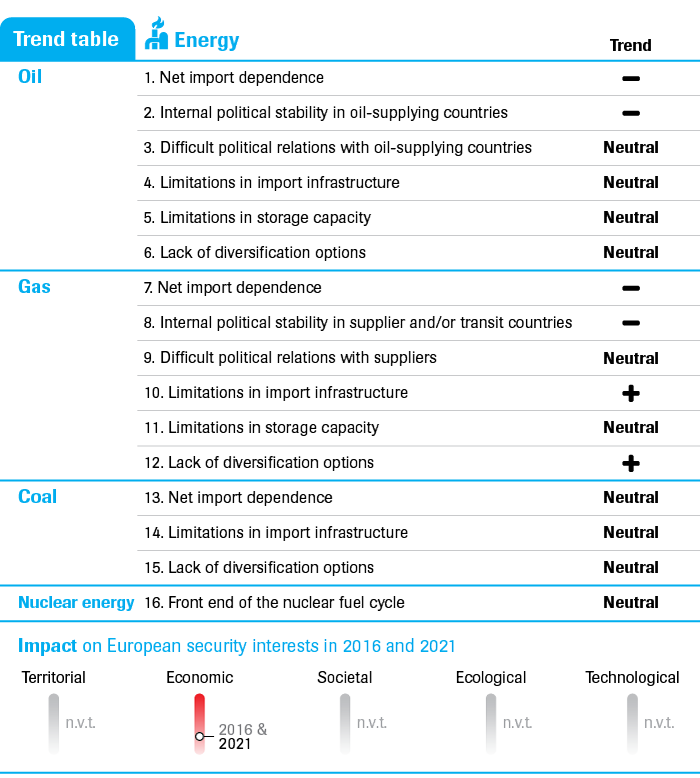
The base rate
Europe’s energy supply is complex. Meeting final energy consumption requires a substantial range of technology, capital goods, infrastructure and human creativity. Getting to the essence of security of energy supply requires, therefore, a gross simplification of the European energy system. Figure 2 is a graphic representation of this system, in which the width of each flow represents the relative amount of energy associated with it. The following trend analysis to 2021 focuses on oil, coal, gas and nuclear energy, for reasons that are presented in more detail in the Energy Appendix.
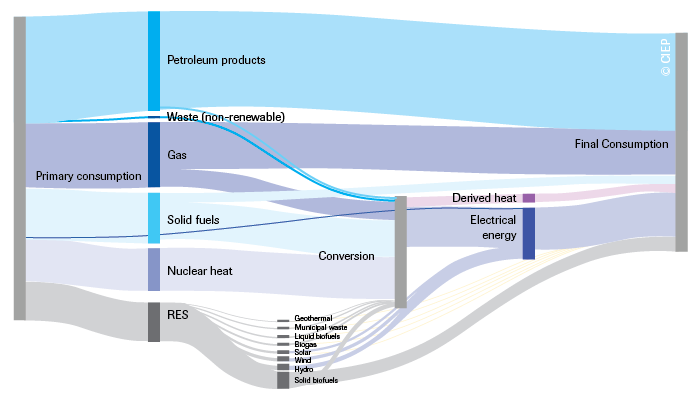
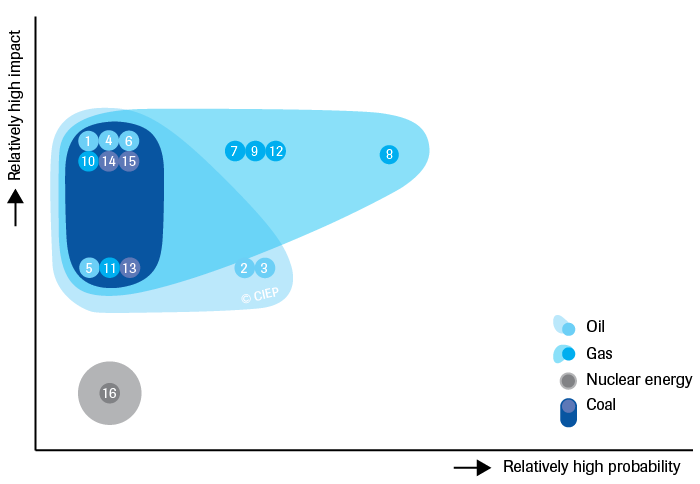
Figure 3 is a schematic representation of the risk analysis and outlines the trend analyses with respect to oil, gas, coal and nuclear energy presented in detail in the Energy Appendix. Each indicator emphasises an aspect that is relevant to security of energy supply, such as internal political stability in countries or difficult political relations (see Table 1 for an overview). For each aspect, the figure reflects whether it is likely to lead to security of energy supply problems (probability) and how great the impact would be (impact) in the period to 2021. In addition, the trend for the next five years is briefly stated (outlook); see Energy Appendix for the analyses per fuel and the detailed supporting analytical framework.
Security of energy supply is difficult to capture in a two-dimensional overview, and the above outline should certainly not be considered in isolation without taking note of the more detailed trend analyses in the Appendix.
The overall picture emerging from the trend analysis is that no major problems with security of energy supply are expected at the aggregate EU level. The fact that the global energy markets are currently characterised by an ample supply is the main reason for this. However, lack of investment in oil and gas around the world may cause price volatility in subsequent years, as the market shifts from being a buyers to a seller’s market.[8] The main point to note in the period to 2021 is the possibility that gas transport through Ukraine from Russia may be interrupted again, affecting security of gas supply in parts of the EU. A disruption of traffic in important shipping straits, such as the Suez Canal, Hormuz or the Bosporus, has implications for maritime oil and gas (LNG) transport. Moreover, much of the EU’s refining capacity is optimalised to process a Russian oil grade. Some international companies are making investments in the EU to make refineries more flexible in terms of types of crude oil and production, but many others are not. As a result, a stronger physical connection exists between producer, processing and the consumption market than macro oil market analyses suggest. Nevertheless, the security of oil supply policy, especially in comparison with other energy sources, is well developed within the IEA, and hence too in the EU.
Impact and shocks
The above analysis shows that over the next five years, no major threats are expected to security of energy supply in Europe. However, if the transport of gas from Russia through Ukraine becomes interrupted again, economic damage in some eastern member states could occur, as described in the Appendix. Whether such damage would be limited or more substantial would depend on the exact nature and duration of the interruption.
Unforeseen and less commonly discussed shocks could change the assessment.[9] The probability of the shocks is relatively low in the period under study (up to 2021), but it useful to discuss a few of them, not least because the uncertainty regarding the probability of occurrence of these shocks increases as the horizon is shifted further into the future.
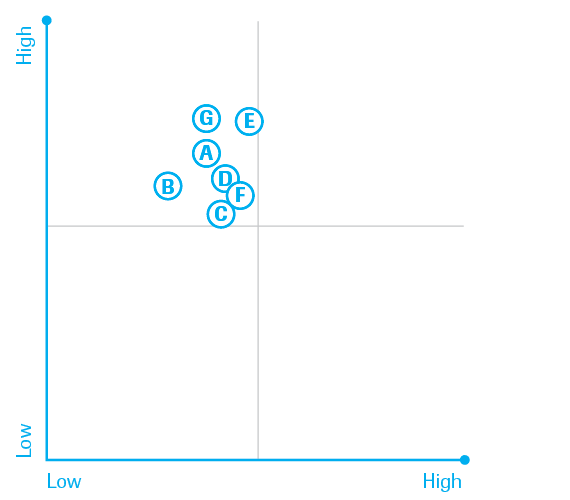
Shock
In a general sense, a supply/demand shock in an energy market, for whatever reason, certainly cannot be excluded. Disruption of exports from a major energy producer such as Saudi Arabia, Qatar or Russia or a radical change of policy by an energy consumer such as China could cut across current trends. The abundant supply of oil would disappear or the current LNG surplus might dwindle away more quickly. The markets are capable of restoring balance to global supply and demand, but the implications of such a shock could be far-reaching. The policy options for safeguarding energy security in the EU could suddenly prove to be more limited. This is why keeping energy options open by means of diversification will always be a worthwhile strategy; the same goes for maintaining good political and other relations with current and potential major energy suppliers.
Second, events may occur in the Middle East that could significantly affect oil production and/or exports. So far, geopolitical instability in the Middle East has not substantially impeded oil production in Iran, Iraq and Saudi Arabia. Asian countries in particular are heavily dependent on supplies from these countries. However, the disruption of production and/or exports by any of these three major producers would have considerable implications for the international oil market, as demand could suddenly greatly exceed supply. Although the international oil market is fairly liquid (so that the initial response would be price changes), infrastructure and the optimisation of refineries for certain oil blends could represent a bottleneck. Fierce competition between certain countries for scarce oil might be the result, and this would have geopolitical repercussions. The disruption of supplies from Russia, for example, would mainly affect the EU due to the increasing regionalisation of the international oil trade, but it would also quickly have a knock-on effect on international oil markets.
A comment on the sustainability of coal use is also called for. Commercial flows relating to coal are often regarded as unaffected by geopolitics. The global market for coal is well developed. Because of coal’s significant CO2 footprint, reservations must be expressed about the future role of coal in the European energy mix in the post-Paris period. This is because there are pressing questions about the medium- to long-term sustainability of the use of coal for electricity production without the application of mitigating technologies such as CO2 capture and storage. It is not inconceivable that the reduction of coal use may occur in fits and starts (driven by political/social debate), and that this might lead, for example, to demand for natural gas, with its smaller CO2 footprint, unexpectedly rising to higher-than-usual levels for the purpose of electricity production. This applies to a greater extent to such changes in large countries such as China or India, where a decrease of coal in the energy mix will have a significant impact on demand for natural gas.
Again, events affecting the availability of nuclear energy are not inconceivable. The EU’s fleet of nuclear production facilities is ageing, and market conditions in the EU make it unattractive to invest in nuclear energy. If these conditions or other factors cause a significant problem with an EU reactor, the role of nuclear energy in the EU could come under severe pressure. The crisis in Fukushima demonstrated the potential (socio-political) implications of a nuclear incident. If a substantial number of nuclear reactors is shutdown (like Japan’s response after Fukushima), this would have enormous implications for the electricity supply in the EU. In particular, it is expected (as in Japan) that electricity production from natural gas would increase, which would push up the EU’s demand for natural gas relative to the normal trend.
A shock in relation to the principle of sanctity of contracts could have a significant impact on the security of gas supply. Long-term gas contracts between producers and consumers have in recent decades made a considerable contribution to security of gas supply. Even when political tensions have arisen, purchase and supply contracts have proved firm: gas continued to be supplied to the paying customer and payments have been made to the supplying producer. Sanctity of contracts reinforces the positive aspects of interdependence, whereas the breaching of contracts has the potential to bring its negative aspects to the fore. When contracts are no longer considered sacred, we enter uncharted territory in the economic relationship. Especially in combination with other shocks (such as those described above, for instance), this could have a particular impact on EU member states’ security of supply.
Finally, events could occur which result in the disintegration of the EU. The result of the Brexit referendum shows that broader and deeper integration of an ever greater number of European countries in the EU is no longer a cast-iron law. Were the EU to disintegrate, it is not a given that every European country would succeed in achieving the three priorities of energy policy (affordable, reliable and clean) in a desirable manner. In terms of security of energy supply, arrangements with regard to oil would still be in place, but other fuels do not fall within the same scope of an international organisation such as the IEA. Regardless of the underlying perspective seen by the EU as ideal, it might be necessary to take such a situation into account.
The energy regime
A threat assessment emerges from the trend analysis in which no immediate major problems are expected for European security of energy supply. An important follow-up question is whether, and to what extent, there is an international system of cooperation and/or coordination that could cope with possible changes to this threat assessment. We will look first at the main actors and institutions of the system, then at the (development of the) most important norms and rules, and finally at whether these norms and rules are actually complied with. What we will see is that energy security is shaped in a hybrid system in which a plurality of state actors, non-state actors and actors with a hybrid character play an important role in policy processes and decision making.
Actors and institutions
Several international organisations coordinate (or attempt to coordinate) international cooperation, bringing together consuming countries (net importers), producing countries (net exporters), or both. In the case of oil, this role is played by the International Energy Agency (IEA), which since November 1974 has brought together net oil-importing countries (of the OECD; Organization of Economic Co-operation and Development), and the Organization of Petroleum Exporting Countries (OPEC), in which oil-exporting countries in the Middle East, South America and Asia have come together since 1960 to defend their interests. For gas, the same role is played by the Gas Exporting Countries Forum(GECF), which is more recent. The IEA is also concerned with gas, although its powers are weaker in terms of security of supply. Finally, a role is also played by the International Energy Forum (IEF), which has overseen dialogue between oil producers and consumers since 1990, and which has now been joined by more countries than the member states of the IEA and OPEC alone. Cooperation in international organisations is intergovernmental in character, with the exception of the International Energy Program (IEP) of the IEA, which has formal powers to determine strategic oil stocks and crisis management.
The EU regulates certain parts of the value chain (transmission and distribution) as legally separate components. Free access to gas infrastructure for third parties (third-party access) is one of the key elements of EU regulation. In the field of gas, ownership of infrastructure and production is separated, so that different types of players (companies) are active in the market. From the perspective of security of supply, the supply of gas is still highly concentrated in some member states, but the internal market with its developed interconnections increases the supply options.[10] European gas companies’ bargaining power has been weakened by the fragmentation of the market, compared to the large state and non-state enterprises on the supply side. By contrast, the organisation of the oil market is subject to less EU regulation (such as the oil and oil product pipelines), with the result that more vertically integrated companies are active in the market, but also companies that only focus on a particular part of the market (refining, production, storage, transport, trade, sale of products). A considerable number of multinationals are still active in the oil market, although here too new players cause a more fragmented market compared to the suppliers.
For oil, the increasing regionalisation of the oil trade is an additional issue. In recent years, the production of oil (and gas) in North America has increased considerably, as a result of which the continent’s imports and exports are almost in balance. In the past, the major trading partners of the Middle Eastern countries were the states of the OECD (Organisation for Economic Co-operation and Development), but today that position is held by the Asian countries (especially China). The main trading partner of the EU for oil is Russia. For both oil and gas, competitors from Asia, especially China, have more market power and a stronger negotiating position.
In addition to governments and international organisations, also companies are active in the energy market, either across the entire value chain for oil and gas (vertically integrated companies) or in a part of the value chain. There are companies that are completely private, companies listed on the international stock exchanges, mixed companies (with or without stock exchange listings) with both private and public shareholders, and public companies (majority-owned by governments). Concerning the last of these categories there has been much debate in connection with promoting the strategic interests of states through energy companies. Some of these state enterprises originate from an EU member state, while others are of foreign state origin (examples for gas: Gazprom, Sonatrach, Gasunie, GasTerra and Statoil; and for oil: Rosneft, Saudi Aramco and CNPC [China], Statoil). There are also companies with sub-national governments as shareholders (such as Rheinisch-Westfälisches Elektrizitätswerk (RWE) and the Dutch network operators).
What emerges from the above description, then, is that security of energy supply is shaped in a hybrid system in which a plurality of state actors, non-state actors and actors with a hybrid character play a distinct role. Discussion has arisen about the strategy of companies with different types of shareholders and the possibility that companies with governments as shareholders may be used to also serve political interests. However, private companies can also influence governments through lobbying, just as NGOs can, to make certain policy decisions that are beneficial to the market position of a particular party.
There is an interplay between geopolitical and geo-economic developments and their impact on energy relations and vice versa.[11] This interaction takes place both between states and companies/markets and within international organisations (see Figures B and C). Due to the development of social media and the Internet, the influence of non-state actors on this process has increased, including across state boundaries (see Figure C). Figure 4 shows how both governments and markets are also part of the solution space.
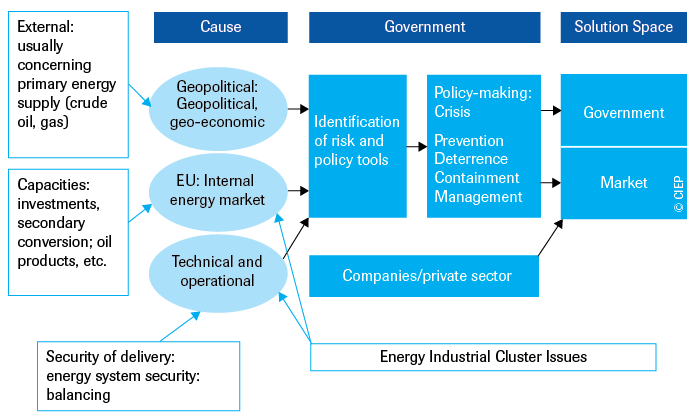
In (geo)political discussions about energy, it can make a difference whether an international market has sufficient liquidity and flexibility to resolve the problem (e.g. of sanctions or disruption). In the energy market, we regularly see that the market can have a problem-solving effect (an example here being the sanctions against Russia, and the fact that the energy market have routinely operated according to the contractual obligations).
Norms and rules
The three principles on the basis of which energy relations are assessed in this analysis are the three priorities of energy policy, namely affordability, reliability and clean energy (see Table 2). These principles can be seen as three norms that are widely shared by various actors (governments, international organisations, national and international companies and NGOs), although with differing degrees of priority. For energy-importing countries, reliability of supplies are important, while for exporting countries, the main concern is reliability of access to markets/customers. Such reliability cannot be considered in isolation from the financial/economic dimension (affordability). And since the renewed focus on energy-related CO2 issues after the climate summit in Paris, clean energy has also become a more prominent concern internationally.
|
Norms |
|---|
|
Affordability |
|
Reliability |
|
Clean energy |
Global contradictions in the field of energy are expected to increase in the period up to 2021. There is a chance that in the run-up to the implementation of the 2030 EU policy framework, more internal conflicts will arise about how member states can give shape to their energy security of supply (contract types) and how new energy technology is supported in the energy mix (only through the Emission Trading System, with or without additional policies). Access to the EU market, through pipelines or via seaports and processing facilities (LNG terminals and oil refineries), may also become a subject of more discussion about rules. At present, much LNG terminal capacity is unused and there is also overcapacity in refining. This should facilitate access to the EU market, but in terms of pipelines (especially but not exclusively with Russia), there is discussion about what kind of regulatory regime is preferable. This uncertainty about infrastructure may eventually also lead to a lack of upstream investments (i.e. in exploration and production), which may not be in the long-term security of energy supply interest of the EU. The development of a southern corridor (through Turkey) may encounter obstacles through political developments there.
The above mentioned shift to regional trade relations in oil (for gas this was already the case, although this has been slightly reduced by the emergence of LNG) also has implications for energy diplomacy. The fact that crude oil is not a homogeneous product and that refineries are often designed for a blend of particular oil grades (usually two) may lead to greater vulnerability or increase the impact in the event of a disruption to the oil flow, beyond what the volume of the disruption might suggest. Moreover, the global trade in oil products is increasing, but these oil products markets are less deep or liquid than the market for crude oil. Decreasing liquidity in the international oil market might make price risks harder to hedge in financial markets.
Compliance
The member states of the organisations share norms, but do not always use the same method of applying the rules regulating the energy market. Work on new plans is ongoing, or a blind eye is (temporarily) turned to the fact that not all the rules are being followed to the letter (for instance, Iraq has not participated in OPEC production policy for a long time). This is often related to specific national situations. The IEF has a charter signed by the member states, but this is fairly general. The IEF is intended primarily as an organisation where important issues can be raised for discussion and information shared (formally and informally).
The quadrant chart and shocks
In the framework of the international system as applied in this Strategic Monitor, the international regime in the field of energy is also shown (see Figure 5). As stated earlier, and as is clear from the foregoing description, the system can be characterised as hybrid, with a multitude of state actors, non-state actors, and actors which themselves have a hybrid character. There are shared norms (inviolability of contracts may be regarded here as a basic sub-norm of reliability), but conflicts have now arisen over rules. Examples here include the energy market liberalisation in the EU and the discomfort experienced by exporters whose interests are affected by new EU regulations, such as the national oil and gas companies from countries such as Algeria (Sonatrach) and Russia (Gazprom). In view of developments in the EU’s energy relations environment (geopolitics and geo-economics), the number of conflicts over rules may have increased by 2021.
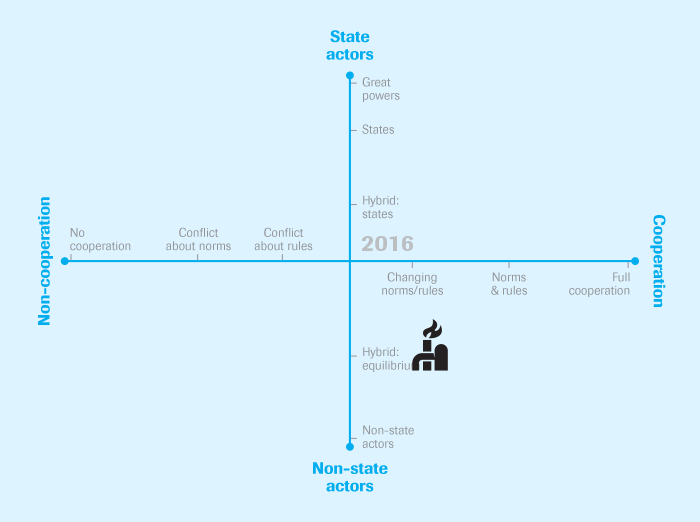
Conclusion
In the period to 2021, further progress will be made in integrating new energy technologies (such as wind and solar) into the energy mix in the EU. However, the contribution of these new energy technologies is still relatively small compared to the conventional energy forms of oil, gas and coal. In the period 2016-2021, given the ample supply on international coal, oil and gas markets, few problems are expected on the supply side; the EU’s large import capacity is another reason for this expectation. Within the EU internal energy market, inter-connections and/or options for reversing flows are lacking in a few regions. The recent EU Winter Package is addressing these issues through public investment.
For subsequent years, the decreased level of investment in the production of these fuels (oil, gas and coal) is a matter of concern, however, especially as the transition to a low-carbon economy will take a long time, and dependence on traditional energy sources will remain high (including as a backup). At the same time, production especially of oil and gas in the EU is decreasing, leading to growing import-dependence even with stagnant demand.
Given the focus on renewable energy sources in EU energy policy, the EU’s oil (and gas) relations may be receiving insufficient attention in light of the economic importance that they will continue to have in the EU economy for a long time. Given the energy developments in North America, the EU will increasingly find itself competing for oil and gas flows with Asian countries. The preservation of good relations in energy trade policy is therefore of great importance.

politiek-en-energie-op-internationaal-systeemniveau_EN.png)
